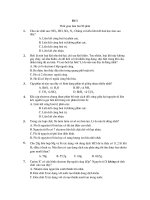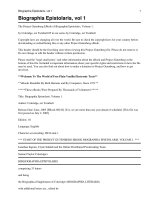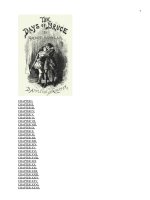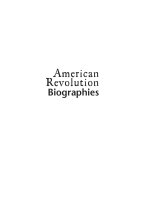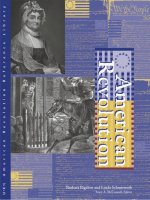American Revolution Biographies.Volume 1: A–J ppt
Bạn đang xem bản rút gọn của tài liệu. Xem và tải ngay bản đầy đủ của tài liệu tại đây (3.34 MB, 275 trang )
Biographies
American
Revolution
AmRev-Bio.V1tpgs 9/29/03 3:44 PM Page 1
Biographies
Linda Schmittroth
and
Mary Kay Rosteck
Stacy A. McConnell, Editor
American
Revolution
Volume 1: A–J
AmRev-Bio.V1tpgs 9/29/03 3:44 PM Page 3
Linda Schmittroth and Mary Kay Rosteck
Staff
Stacy McConnell, U•X•L Editor
Judy Galens, U•X•L Contributing Editor
Carol DeKane Nagel, U•X•L Managing Editor
Thomas L. Romig, U•X•L Publisher
Margaret Chamberlain, Permissions Specialist (Pictures)
Rita Wimberley, Senior Buyer
Evi Seoud, Assistant Production Manager
Dorothy Maki, Manufacturing Manager
Tracey Rowens, Senior Art Director
LM Design, Typesetting
Library of Congress Cataloging-in-Publication Data
Schmittroth, Linda
American Revolution : biographies / Linda Schmittroth and Mary Kay
Rosteck ; edited by Stacy McConnell.
p. cm.
Includes bibliographical references and index.
Summary: Profiles sixty men and women who were key players on the
British or American side of the American Revolution.
ISBN 0-7876-3792-0 (set) — ISBN 0-7876-3793-9 (v. 1). — ISBN 0-7876-
3794-7 (v. 2)
1. United States—History—Revolution, 1775-1783—Biography—Juvenile
literature. [1. United States—History—Revolution, 1775-1783—Biography.]
I. Rosteck, Mary Kay. II. McConnell, Stacy A. III. Title.
E206 .S36 2000
973.3’092’2—dc21 99-046941
CIP
This publication is a creative work fully protected by all applicable copy-
right laws, as well as by misappropriation, trade secret, unfair competition,
and other applicable laws. The authors and editors of this work have added
value to the underlying factual material herein through one or more of the
following: unique and original selection, coordination, expression,
arrangement, and classification of the information. All rights to this pub-
lication will be vigorously defended.
Copyright © 2000 U•X•L, an imprint of The Gale Group
All rights reserved, including the right of reproduction in whole or in part
in any form.
Front cover photographs (top to bottom): Crispus Attucks reproduced
courtesy of the Library of Congress; Patrick Henry reproduced courtesy of
the Library of Congress.
Back cover photograph: Mount Vernon reproduced by permission of the
Detroit Photographic Company.
Printed in the United States of America
10 9 8 7 6 5 4 3 2 1
American Revolution: Biographies
AmRevBioFM.qxp 7/29/03 3:00 PM Page iv
Advisory Board ix
Reader’s Guide xi
Timeline xiii
Words to Know xxiii
Volume 1: A-J
Abigail Adams 1
John Adams 9
Samuel Adams 20
Ethan Allen 31
Benedict Arnold 38
Black Freedom Fighters 46
Joseph Brant 54
Mary “Molly” Brant 63
John Burgoyne 71
Edmund Burke 81
Margaret Cochran Corbin 90
v
Contents
AmRevBioFM.qxp 7/29/03 3:00 PM Page v
Hector St. John de Crèvecoeur 97
John Dickinson 105
Benjamin Franklin 114
Deborah Read Franklin 125
Elizabeth Freeman 131
Thomas Gage 138
Bernardo de Gálvez 147
George III 155
Simon Girty 164
Mary Katherine Goddard 173
Nathan Hale 178
Alexander Hamilton 187
John Hancock 198
Nancy Morgan Hart 210
Patrick Henry 218
William Howe 228
John Jay 237
Thomas Jefferson 246
Index xxxiii
Volume 2: K-Z
Thaddeus Kosciuszko 257
Marquis de Lafayette 264
Pierre Charles L’Enfant 275
Louis XVI 284
Flora Macdonald 294
James Madison 302
George Mason 312
Mary McCauley (“Molly Pitcher”) 321
Jane McCrea 328
Judith Sargent Murray 338
Jonathan Odell 345
Thomas Paine 353
William Pitt 361
Casimir Pulaski 370
David Ramsay 379
Esther De Berdt Reed 385
Paul Revere 391
Frederika von Riedesel 399
James Rivington 408
vi American Revolution: Biographies
AmRevBioFM.qxp 7/29/03 3:00 PM Page vi
Betsy Ross 417
Benjamin Rush 426
Deborah Sampson 434
Daniel Shays 443
Charles Townshend 451
Horace Walpole 459
Mercy Otis Warren 468
George Washington 478
Phillis Wheatley 489
John Wilkes 499
Index xxxiii
Contents vii
AmRevBioFM.qxp 7/29/03 3:00 PM Page vii
S
pecial thanks are due for the invaluable comments and sug-
gestions provided by U•X•L’s American Revolution Refer-
ence Library advisors:
• Mary Alice Anderson, Media Specialist, Winona Middle
School, Winona, Minnesota.
• Jonathan Betz-Zall, Children’s Librarian, Sno-Isle Regional
Library System, Edmonds, Washington.
• Frances Bryant Bradburn, Section Chief, Information Tech-
nology Evaluation Services, Public Schools of North Car-
olina, Raleigh, North Carolina.
• Sara K. Brooke, Director of Libraries, Ellis School, Pittsburgh,
Pennsylvania.
• Peter Butts, Media Specialist, East Middle School, Holland,
Michigan.
ix
Advisory Board
AmRevBioFM.qxp 7/29/03 3:01 PM Page ix
A
merican Revolution: Biographies presents biographies of
sixty men and women who took part in, influenced, or
were in some way affected by the American Revolution. Among
the people profiled in each of the two volumes are American
patriots and presidents; colonists who remained loyal to Eng-
land; Native Americans, royalty, politicians, scoundrels, and
military officers from foreign nations who helped or hindered
the American fight for freedom; writers, poets, and publishers;
and heroic colonial women who wrote, took up arms, acted as
spies, or raised funds for American independence.
American Revolution: Biographies not only includes the
biographies of such famous patriots as George Washington,
Benjamin Franklin, John Adams, Samuel Adams, Thomas
Paine, and Thomas Jefferson, it also features the life stories of
less celebrated people such as Phillis Wheatley, renowned poet
and former slave; Frenchman Pierre Charles L’Enfant, who
designed the city of Washington, D.C.; Deborah Sampson, a
woman who donned a military uniform and served as an army
soldier; and Frederika von Riedesel, a German who chronicled
the Revolution while traveling throughout the colonies with
her young family as her husband fought for the British.
xi
Reader’s Guide
AmRevBioFM.qxp 7/29/03 3:01 PM Page xi
Other features
American Revolution: Biographies also highlights interest-
ing people with ties to the main biography subjects, and adds
details that help round out events of the Revolutionary period.
Each entry contains cross-references to other individuals pro-
filed in the two-volume set, and each offers a list of sources—
including web sites—for further information about the indi-
vidual profiled. A timeline and glossary introduce each volume
and a cumulative subject index concludes each volume.
American Revolution: Biographies has two companion
volumes: American Revolution: Almanac, which describes in
narrative form the events leading up to the war and the major
events of the war; and American Revolution: Primary Sources,
which contains excerpts from more than thirty Revolutionary-
era documents.
Acknowledgments
The authors wish to thank Mary Reilly McCall, who
contributed encouragement, enthusiasm, and several biogra-
phies to this set.
Comments and suggestions
We welcome your comments on this work as well as
your suggestions for topics to be featured in future editions of
American Revolution: Biographies. Please write: Editors, American
Revolution: Biographies, U•X•L, 27500 Drake Rd., Farmington
Hills, MI 48331-3535; call toll-free: 1-800-877-4253; fax: 248-
414-5043; or send e-mail via www.galegroup.com.
xii American Revolution: Biographies
AmRevBioFM.qxp 7/29/03 3:01 PM Page xii
xiii
1754 Start of the French and Indian War, pitting the French
and their Indian allies against the British for control of
North America.
1760 George III becomes King of England.
1762 James Otis Jr., brother of Mercy Otis Warren, pub-
lishes a pamphlet arguing for a limitation on Parlia-
ment’s right to interfere with colonial affairs.
1763 French and Indian War ends with a British victory. To
appease Native Americans, King George III forbids colo-
nial settlement west of the Appalachian Mountains.
1765 In March, King George III approves the Stamp Act,
which taxes the American colonies to pay for the French
and Indian War. Horace Walpole, British Member of
Parliament, opposes the Stamp Act before Parliament
and speaks out for the rights of American colonists.
In July, Boston patriots (“Sons of Liberty”) unite in
opposition to the Stamp Act. In August, a mob destroys
the house of Massachusetts Lieutenant Governor
Thomas Hutchinson to protest the act.
Timeline of Events in
Revolutionary America
AmRevBioFM.qxp 7/29/03 3:01 PM Page xiii
In September, Deborah Read Franklin defends her
property when an angry mob outside her home
protests that her husband, Benjamin Franklin, has
not fought vigorously enough against the Stamp Act.
In October, delegates at a Stamp Act Congress adopt
John Dickinson’s Declaration of Rights and Griev-
ances, protesting the Stamp Act.
1766 The British government repeals the Stamp Act and
replaces it with the Declaratory Act, asserting Eng-
land’s right to make laws that colonists must obey.
British politician William Pitt makes a famous speech
in Parliament, declaring his opinion that Britain “has
no right to lay a tax upon” the American colonies.
1767 In June, British politician Charles Townshend pushes
through Parliament the Townshend Acts, imposing
new taxes on American colonists.
In December, John Dickinson’s “Letters from a Farmer
in Pennsylvania” appear in colonial newspapers,
protesting Parliament’s power to tax the colonies.
1768 In February, Samuel Adams writes a letter opposing
taxation without representation and calls for the
colonists to unite against British oppression.
In May, British troops arrive in Boston to enforce the
Townshend Acts.
In June, tax collectors seize John Hancock’s ship the
Liberty and sell its cargo.
1769 George Mason’s Virginia Resolves, which opposes
British taxation and other policies, is presented to Vir-
ginia lawmakers.
1770 Benjamin Rush publishes the first American chem-
istry textbook.
Hector St. John de Crèvecoeur begins writing the
pieces that are later published as Letters from an Ameri-
can Farmer.
In March, during the Boston Massacre, five colonists
are killed by British soldiers, including a black man
named Crispus Attucks.
xiv American Revolution: Biographies
AmRevBioFM.qxp 7/29/03 3:01 PM Page xiv
In April, most of the Townshend Acts are repealed by
Parliament, except the tax on tea.
In October, John Adams and Josiah Quincy success-
fully defend British soldiers on trial for firing shots
during the Boston Massacre.
In November, at the urging of Samuel Adams, a com-
mittee of correspondence is formed in Boston; it issues
a declaration of rights and a list of complaints against
British authorities.
1772 Mercy Otis Warren’s patriotic play The Adulateur is
published.
1773 Phillis Wheatley’s Poems on Various Subjects, Religious
and Moral is published in London and sold in Boston.
In May, the Tea Act, a new tea tax, takes effect.
In December, patriots protest the Tea Act by throwing
crates of tea into Boston Harbor (the Boston Tea Party).
1774 In March, Parliament passes the Intolerable Acts to
punish Boston for the Boston Tea Party.
In May, British General Thomas Gage replaces Thomas
Hutchinson as Royal Governor of Massachusetts.
In September, the First Continental Congress meets in
Philadelphia to discuss the tense situation with Great
Britain.
In October, Massachusetts lawmakers, including John
Hancock, begin war preparations.
1775 In March, British politician Edmund Burke gives his
speech “On Conciliation” before Parliament, urging
the British government to settle differences with
colonists. Patrick Henry gives a famous speech to Vir-
ginia lawmakers explaining why Virginia must arm a
citizen army to confront the British.
In April, Massachusetts governor Thomas Gage is told
to put down the “open rebellion” of the colonists
using all necessary force. Paul Revere rides to Concord
and Lexington to warn the patriots that British soldiers
are on the way. The first shots of the Revolutionary
War are fired between Minutemen and British soldiers
at Concord. The British retreat to Boston. British politi-
Timeline xv
AmRevBioFM.qxp 7/29/03 3:01 PM Page xv
cian John Wilkes presents a petition to King George
III protesting his treatment of the colonies.
In May, Governor Thomas Gage imposes martial law
in Massachusetts. The Green Mountain Boys, led by
Benedict Arnold and Ethan Allen, capture Fort Ticon-
deroga in New York. The Second Continental Congress
meets in Philadelphia and appoints John Hancock its
president. Mary Katherine Goddard becomes pub-
lisher of Maryland Journal and keeps colonists informed
about events in the fight for independence.
In June, George Washington is appointed comman-
der-in-chief of a new Continental army. Before he
arrives in Boston, patriots are defeated by British at the
Battle of Bunker Hill.
In July, George Washington takes command of Conti-
nental army outside Boston. The Continental Con-
gress approves John Dickinson’s Olive Branch Peti-
tion calling for King George III to prevent further
hostile actions against the colonists until a reconcilia-
tion can be worked out. Benjamin Franklin is
appointed first American Postmaster General.
In August, King George III declares the colonies in
open rebellion against Great Britain.
In November, James Rivington’s print shop is burned
to the ground because patriots are upset that his news-
paper publishes articles presenting both sides of the
quarrel between England and America.
In December, Continental army soldiers under Bene-
dict Arnold fail in an attempt to capture Quebec,
Canada.
King George III proclaims the closing of American
colonies to all trade effective March 1776.
1776 In January, Thomas Paine’s Common Sense is pub-
lished, in which he urges independence from England.
In March, British general William Howe and his
troops abandon Boston for Canada; patriots reclaim
Boston. Abigail Adams writes her famous “Remember
the Ladies” letter to John Adams.
xvi American Revolution: Biographies
AmRevBioFM.qxp 7/29/03 3:01 PM Page xvi
In May, the Continental Congress tells each of the
thirteen colonies to form a new provincial (local) gov-
ernment.
In June, George Mason proposes a plan for a state gov-
ernment to Virginia lawmakers. Betsy Ross of Philadel-
phia is believed to design the first American stars and
stripes flag.
In July, Congress adopts the Declaration of Indepen-
dence. A massive British force lands in New York City
to crush colonial rebellion.
In August, General William Howe defeats George
Washington at the Battle of Long Island, New York. In
the fighting, Margaret Cochran Corbin steps in and
takes over firing a cannon when her soldier husband is
killed by enemy fire.
In September, Benjamin Franklin is one of three men
appointed by Congress to go to Paris to seek French
assistance in the war. Nathan Hale is executed by the
British for spying.
In October, the American navy is defeated at Battle of
Valcour in Canada, in which Benedict Arnold com-
mands a fleet of American ships.
In December, George Washington’s troops flee to
Pennsylvania; fearing attack, the Continental Con-
gress abandons Philadelphia for Baltimore. The Conti-
nental army defeats Great Britain’s hired German sol-
diers in a surprise attack at Trenton, New Jersey.
1777 Loyalist Flora Macdonald refuses to take an oath of
allegiance to America and loses her plantation.
In June, British general John Burgoyne’s troops cap-
ture Fort Ticonderoga from the Americans. George
Washington loses at Brandywine and Germantown
near Philadelphia; the British seize Philadelphia.
In July, France’s Marquis de Lafayette is appointed
major general of the Continental army. Jane McCrea
is killed by Indians scouting for the British. Polish war
hero Casimir Pulaski arrives to help the American
cause.
Timeline xvii
AmRevBioFM.qxp 7/29/03 3:01 PM Page xvii
In August, Mohawk Indian Mary “Molly” Brant
reports American troop movements to the British, who
then beat the Americans at the Battle of Oriskany, New
York.
In September, German general Friederich von Riedesel
helps the British win the first Battle of Saratoga at Free-
man’s Farm, New York.
In October, Polish soldier Thaddeus Kosciuszko helps
Americans defeat General John Burgoyne at Saratoga,
New York. Baroness Frederika von Riedesel and her
family are captured by the Americans.
In November, the Continental Congress adopts the
Articles of Confederation, America’s first constitution.
In December, George Washington’s troops set up win-
ter quarters at Valley Forge, Pennsylvania. France’s
King Louis XVI recognizes American independence,
paving the way to openly assist the war effort.
1778 In February, France and the United States sign treaties
of trade and alliance. German Baron von Steuben joins
the Continental army as Inspector General and begins
to train troops.
In March, the British fail at an attempt to make peace
with the Americans. Frontiersman Simon Girty goes
over to the British side.
In June, General Sir Henry Clinton (who replaced
William Howe) abandons Philadelphia and heads for
New York. On the way, he is attacked by Americans at
the Battle of Monmouth, New Jersey. Mary McCauley
(“Molly Pitcher”) participates in the battle.
In July, France declares war on Great Britain.
1779 Essays and poems by Jonathan Odell are printed in
newspapers; they encourage the Loyalists and criticize
the Continental Congress.
Spain declares war on Great Britain. Bernardo de
Gálvez, the Spanish governor of Louisiana, begins to
openly aid the American cause.
1780 In May, Charleston, South Carolina, falls to British
troops.
xviii American Revolution: Biographies
AmRevBioFM.qxp 7/29/03 3:01 PM Page xviii
In June, Massachusetts’s constitution asserts that “all
men are born free and equal”; this includes black
slaves. In Sentiments of an American Woman, Esther De
Berdt Reed calls on colonial women to sacrifice luxu-
ries and instead give money to the American army.
In September, Benedict Arnold openly goes over to
the British side.
1781 In March, the Articles of Confederation are ratified by
all the states.
In August, Elizabeth Freeman, a slave living in Mass-
achusetts, sues and wins her freedom under the new
Massachusetts constitution.
In October, British general Charles Cornwallis surren-
ders his troops at Yorktown, Virginia; Great Britain
loses all hope of winning the Revolutionary War.
1782 Benjamin Franklin, John Adams, John Jay, and
Henry Laurens go to France to draw up a peace treaty.
Deborah Sampson, disguised as a man, enlists in the
Fourth Massachusetts Regiment and fights against the
Tories and Native Americans.
1783 Mohawk Chief Joseph Brant and the Iroquois Confed-
eracy begin blocking American westward expansion.
In April, Congress declares the Revolutionary War offi-
cially ended; Loyalists and British soldiers pack up
their headquarters in New York City and depart for
Canada or England.
In May, the Society of Cincinnati is formed by former
Continental army officers. Among its early members
are George Washington, Alexander Hamilton, and
Thaddeus Kosciuszko.
In November, George Washington delivers a farewell
speech to his army; he resigns his military commission.
1784 In January, the Treaty of Paris is ratified by Congress,
bringing the Revolutionary War to an official end.
In March, Thomas Jefferson’s plan for dividing the
western territories is adopted by Congress.
1785 In January, Congress relocates to New York City.
Timeline xix
AmRevBioFM.qxp 7/29/03 3:01 PM Page xix
In February, John Adams becomes the first U.S.
ambassador to England.
1786 In January, Thomas Jefferson’s Virginia Statute for
Religious Freedom is passed by the Virginia legislature.
In August, Daniel Shays masterminds Shays’s Rebel-
lion to protest what he calls unfair taxation.
In September, the Annapolis Convention meets;
Alexander Hamilton proposes and Congress approves
his plan for a 1787 convention to replace the Articles
of Confederation with a Constitution.
1787 In May, convention delegates meet in Philadelphia to
rewrite the Articles of Confederation.
In July, Congress adopts the Northwest Ordinance
(order), based on one written earlier by Thomas Jef-
ferson, that prohibits slavery in U.S. territories and
provides a method for new states to enter the union.
In October, Alexander Hamilton, James Madison,
and John Jay publish the Federalist in defense of the
new American Constitution.
1788 In February, in Massachusetts, Samuel Adams and
John Hancock agree to support the new Constitution,
but only if amendments will be added that guarantee
civil liberties.
In June, in Virginia, James Madison and his followers
succeed in getting ratification of the Constitution
despite opposition by Patrick Henry and George
Mason. The U.S. Constitution is adopted by all of the
states. Congress is granted land for a new federal
capital.
In July, Congress formally announces that the Consti-
tution of the United States has been ratified and is in
effect.
In September, New York City is named the temporary
seat of the new U.S. government.
1789 David Ramsay’s History of the Revolution is published.
In April, George Washington is sworn in as the first
U.S. president.
xx American Revolution: Biographies
AmRevBioFM.qxp 7/29/03 3:01 PM Page xx
In July, the French Revolution begins in Paris. King
Louis XVI will be beheaded in 1792 during this revo-
lution.
In September, the U.S. Army is established by Congress.
1791 The Bill of Rights, written by James Madison, is passed
by the U.S. Congress.
Pierre Charles L’Enfant is appointed to design the
new federal capital, Washington, D.C.
1792 Judith Sargent Murray writes an essay stating that
women are born equal to men and have the capability
to enter all professions if properly educated.
1797 John Adams becomes the second U.S. president.
1801 Thomas Jefferson becomes the third U.S. president.
1912 The discovery of five skeletons near her property seems
to prove true the legend that Nancy Morgan Hart killed
five Tory soldiers during the American Revolution.
Timeline xxi
AmRevBioFM.qxp 7/29/03 3:01 PM Page xxi
A
Abolitionism: The belief that measures should be taken to end
slavery.
Absolutism: Also known as absolute power; a system in which
one person—usually a king or queen—rules without
any kind of restrictions on his or her actions.
Agent: A person who conducts business on another’s behalf.
Allegiance: Loyalty to king, country, or a cause.
Articles of Confederation: An agreement among the thirteen
original states, approved in 1781, that provided a loose
form of government before the present Constitution
went into effect in 1789.
Artillery: The science of using guns; a group of gunners in an
army; or the weapons themselves, especially cannons
that throw bombs across a battlefield.
Assemblies: One of the names used by the colonies for their
lawmaking bodies.
xxiii
Words to Know
AmRevBioFM.qxp 7/29/03 3:01 PM Page xxiii
B
Boston Massacre: An encounter between British troops and
townspeople in Boston in 1770, before the Revolu-
tionary War. The British fired into a crowd and five
Americans were killed.
Boston Tea Party: An incident on December 16, 1773, in
which Boston patriots dumped 342 chests of English
tea into Boston Harbor to protest British taxes.
Boycott: A refusal to buy, sell, or use certain products from a
particular company or country, usually for a political
reason.
Brigadier general: A military position just below major gen-
eral.
Bunker Hill, Battle of: The first great battle of the Revolu-
tionary War, fought near Boston in June 1775. The
British drove the Americans out of their fort at nearby
Breed’s Hill to Bunker Hill; the Americans gave up only
when they ran out of ammunition, proving they were
willing to take on trained British soldiers.
Burgesses: An old term for members of the British Parliament;
the lawmaking body of colonial Virginia called itself
the House of Burgesses.
C
Coercive Acts: The British name for the Intolerable Acts.
Colonel: A military rank below brigadier general.
Colonial: Relating to the period before the United States
declared independence.
Colonial agents: Men appointed by lawmaking bodies in the
colonies to live in London, England, circulate among
important people, and report back on what was hap-
pening in the British Parliament. Benjamin Franklin
served as an agent for several colonies.
Colonies: Territories that are settled by emigrants from a dis-
tant land and remain subject to or closely connected
with the parent country.
Committees of Correspondence: Colonial groups that shared
information, coordinated the activities of colonial agi-
xxiv American Revolution: Biographies
AmRevBioFM.qxp 7/29/03 3:01 PM Page xxiv
tators, and organized public opinion against the
British government.
Committees of Safety: One of many colonial committees that
had the authority to call up militias (groups of volun-
teer soldiers) when they were needed.
Common Sense: A pamphlet written by Thomas Paine in 1776
in which he urged the colonies to declare indepen-
dence immediately.
Confederacy: A union of states.
Confederation: A group of states united for a common purpose.
Conservatives: People who wish to preserve society’s existing
institutions.
Continental army: An army of American colonists formed
during the American Revolution.
Continental Congress: An assembly of delegates from the
American colonies (later states). The delegates gov-
erned before and during the Revolutionary War and
under the Articles of Confederation. The Continental
Congress first met in 1774.
The Crisis: Also known as The American Crisis, a series of pam-
phlets written by Thomas Paine in which he discussed
issues of the American Revolution.
D
Declaration of Independence: The document establishing
the United States as a nation, adopted by the Conti-
nental Congress on July 4, 1776.
Delegates: Representatives.
Democracy: A system of government in which power belongs
to the people, who rule either directly or through
freely elected representatives. See also Republic.
“Don’t fire until you see the whites of their eyes”: A famous
command said to have been given by either William
Prescott or Israel Putnam, American officers at the Bat-
tle of Bunker Hill. In order for colonial weapons to be
effective, the shooter had to be close to his victim.
Duties: Taxes on imported or exported goods.
xxvWords to Know
AmRevBioFM.qxp 7/29/03 3:01 PM Page xxv
E
Essays: Short pieces of writing that deal with a single subject.
F
Federalist: One who supports a strong central government
instead of a loose organization of states.
Founding Fathers: A general name for male American patriots
during the Revolutionary War, especially the signers of
the Declaration of Independence and the drafters of
the Constitution.
Freedom of the press: The right to circulate opinions in print
without government interference.
French and Indian War: A series of military battles between
Great Britain and France (and France’s Indian allies)
that took place on the American frontier and in
Canada between 1754 and 1763.
French Revolution: An event lasting from 1789 to 1799 that
ended the thousand-year rule of kings in France and
established France as a republic. The American Revolu-
tion and the American experiment with democracy
was an inspiration to many French people, but while
the American experiment thrived, the French Revolu-
tion ended in chaos.
G
Great Britain: The island off the western coast of Europe made
up of England, Scotland, and Wales. Also called
“Britain” or “England.”
Grievances: Complaints.
H
Hessians: Citizens of Hesse-Cassel, once a part of Germany.
German soldiers (mercenaries) were hired by King
George III to fight for the British in the American Rev-
olution. Many came from Hesse-Cassel; as a result, all
German soldiers were called Hessians.
xxvi American Revolution: Biographies
AmRevBioFM.qxp 7/29/03 3:01 PM Page xxvi
I
Intolerable Acts: Four laws passed by the British government
in 1774 to punish Boston for the Boston Tea Party.
Iroquois Confederacy: A union of the Mohawk, Oneida,
Onondaga, Cayuga, Seneca, and Tuscarora tribes.
Members were sometimes called “Iroquois” instead of
their tribal names.
L
Lexington and Concord, Battle of: The first battle of the Rev-
olutionary War, a minor skirmish fought in Massachu-
setts on April 19, 1775.
Loyalists: Colonists who remained loyal to England during
the American Revolution; also known as Tories.
M
Martial law: Temporary rule by military authorities imposed
upon regular citizens in time of war or when civil
authority has stopped working. The British-appointed
governor of Virginia became so angry at Patrick
Henry’s “give me liberty or give me death” speech that
he declared martial law in Virginia.
Mercenaries: Soldiers for hire; see Hessians.
Militia: A military force consisting of citizens rather than pro-
fessional soldiers.
Minutemen: Armed American citizens (nonmilitary) who
promised to be ready to fight alongside regular soldiers
at a moment’s notice.
Monarchy: Rule by a king or queen.
N
Neutral: Not committed to either side of an issue.
New England: The region in the northeastern United States
that includes present-day Connecticut, Maine, Massa-
chusetts, New Hampshire, Rhode Island, and Vermont.
xxviiWords to Know
AmRevBioFM.qxp 7/29/03 3:01 PM Page xxvii
xxviii American Revolution: Biographies
The name was probably given by English explorer Cap-
tain John Smith, one of the original settlers of
Jamestown, Virginia (1607), because the region resem-
bled the coast of England.
“No taxation without representation”: A popular phrase of
the Revolutionary War era. The colonists were not
allowed to choose representatives to Parliament, which
passed laws taxing the colonists. This offense against
colonial rights is one of the main grievances against
Great Britain listed in the Declaration of Independence.
P
Pamphlets: Reading material with paper covers.
Parliament: The British lawmaking body.
Patriot: A person who loves, supports, and defends his country.
Petition: A formal document.
Privateer: A privately owned ship authorized by the govern-
ment during wartime to attack and capture enemy ves-
sels. Privateer may also refer to the person who com-
mands the ship.
Propaganda: Information and argument designed to influ-
ence public opinion about political matters.
Q
Quaker: A member of the religion known as the Society of
Friends. Quakers oppose all violence and warfare.
Quota: A share assigned to a group. During the American Rev-
olution, when too few men volunteered to be soldiers
in the Continental army, Congress assigned a quota to
each colony, representing the number of men the
colony was expected to round up and send to serve in
the army.
R
Radical: A person who favors revolutionary changes in a
nation’s political structure.
AmRevBioFM.qxp 7/29/03 3:01 PM Page xxviii


